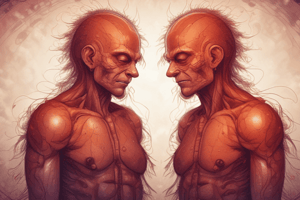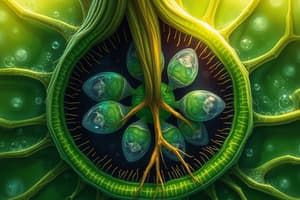Podcast
Questions and Answers
Which treatment regimen is considered the treatment of choice for fit patients with Hairy Cell Leukemia?
Which treatment regimen is considered the treatment of choice for fit patients with Hairy Cell Leukemia?
- FCR regimen (correct)
- Chemotherapy alone
- Radiation therapy
- BR regimen
Patients with Hairy Cell Leukemia are primarily affected in the age group of 30-50 years.
Patients with Hairy Cell Leukemia are primarily affected in the age group of 30-50 years.
False (B)
What is the primary cell type from which Hairy Cell Leukemia originates?
What is the primary cell type from which Hairy Cell Leukemia originates?
Memory B cells
In Hairy Cell Leukemia, patients may experience __________ due to bone marrow infiltration.
In Hairy Cell Leukemia, patients may experience __________ due to bone marrow infiltration.
Match the following prognostic factors with their associated outcomes:
Match the following prognostic factors with their associated outcomes:
Which organism is associated with causing MALTOMA?
Which organism is associated with causing MALTOMA?
Stage II lymphoma involves lymph node regions on both sides of the diaphragm.
Stage II lymphoma involves lymph node regions on both sides of the diaphragm.
What are the four stages of lymphoma according to the Ann-Arbor staging system?
What are the four stages of lymphoma according to the Ann-Arbor staging system?
____ is the causative organism associated with Adult T-cell leukemia/lymphoma.
____ is the causative organism associated with Adult T-cell leukemia/lymphoma.
Match the following lymphomas with their causative organisms:
Match the following lymphomas with their causative organisms:
What is the most common type of marginal zone lymphoma (MZL)?
What is the most common type of marginal zone lymphoma (MZL)?
Richter transformation occurs in 5% of patients with low-grade lymphoma per year.
Richter transformation occurs in 5% of patients with low-grade lymphoma per year.
What is the treatment approach for symptomatic cases of Non-Hodgkin's lymphoma with a low tumor burden?
What is the treatment approach for symptomatic cases of Non-Hodgkin's lymphoma with a low tumor burden?
The primary association of Maltoma is with ______ in 95% of cases.
The primary association of Maltoma is with ______ in 95% of cases.
Match the following clinical features to their respective lymphomas:
Match the following clinical features to their respective lymphomas:
What is the most common presenting feature of Mantle Cell Lymphoma?
What is the most common presenting feature of Mantle Cell Lymphoma?
Mantle Cell Lymphoma primarily affects younger individuals.
Mantle Cell Lymphoma primarily affects younger individuals.
Which genetic marker is commonly associated with Mantle Cell Lymphoma?
Which genetic marker is commonly associated with Mantle Cell Lymphoma?
Mantle Cell Lymphoma is classified as a ___ malignancy originating from pre-germinal centers.
Mantle Cell Lymphoma is classified as a ___ malignancy originating from pre-germinal centers.
Match the following features with their associated type of lymphoma:
Match the following features with their associated type of lymphoma:
Which immunophenotyping markers are positive for Hairy Cell Leukemia?
Which immunophenotyping markers are positive for Hairy Cell Leukemia?
Fried egg appearance is a characteristic associated with Hairy Cell Leukemia bone marrow biopsy findings.
Fried egg appearance is a characteristic associated with Hairy Cell Leukemia bone marrow biopsy findings.
What is the primary treatment option for Hairy Cell Leukemia?
What is the primary treatment option for Hairy Cell Leukemia?
In Hairy Cell Leukemia, patients may exhibit __________ on a peripheral smear.
In Hairy Cell Leukemia, patients may exhibit __________ on a peripheral smear.
Match the following treatments with their descriptions:
Match the following treatments with their descriptions:
What is a common blood count finding in Chronic Lymphocytic Leukemia?
What is a common blood count finding in Chronic Lymphocytic Leukemia?
Richter transformation is characterized by low-grade lymphoma with increased lymphadenopathy.
Richter transformation is characterized by low-grade lymphoma with increased lymphadenopathy.
What is the first stage of the Rai and Binet staging system for Chronic Lymphocytic Leukemia?
What is the first stage of the Rai and Binet staging system for Chronic Lymphocytic Leukemia?
The peripheral smear in Chronic Lymphocytic Leukemia often shows small, blue, round __________.
The peripheral smear in Chronic Lymphocytic Leukemia often shows small, blue, round __________.
Match the following stages of Chronic Lymphocytic Leukemia with their features:
Match the following stages of Chronic Lymphocytic Leukemia with their features:
Which marker is NOT associated with the Pre-germinal center?
Which marker is NOT associated with the Pre-germinal center?
Centrocytes are the product of somatic hypermutation in the Germinal Center.
Centrocytes are the product of somatic hypermutation in the Germinal Center.
Name one type of lymphoma associated with the Post-germinal cell zone.
Name one type of lymphoma associated with the Post-germinal cell zone.
The marker _______ indicates a Plasma Cell variant associated with Multiple Myeloma.
The marker _______ indicates a Plasma Cell variant associated with Multiple Myeloma.
Match the following lymphomas with their associated markers:
Match the following lymphomas with their associated markers:
Which of the following is a characteristic feature of Diffuse Large B-cell Lymphoma (DLBCL)?
Which of the following is a characteristic feature of Diffuse Large B-cell Lymphoma (DLBCL)?
Burkitt's lymphoma is characterized by elevated LDH and hypoalbuminemia.
Burkitt's lymphoma is characterized by elevated LDH and hypoalbuminemia.
What is a hallmark cell associated with DLBCL?
What is a hallmark cell associated with DLBCL?
Anaplastic large B-cell lymphoma is associated with the genetic alteration known as t(;).
Anaplastic large B-cell lymphoma is associated with the genetic alteration known as t(;).
Match the following lymphoma types with their characteristics:
Match the following lymphoma types with their characteristics:
What is the median age of diagnosis for Chronic Lymphocytic Leukemia (CLL)?
What is the median age of diagnosis for Chronic Lymphocytic Leukemia (CLL)?
Chronic Lymphocytic Leukemia primarily affects females.
Chronic Lymphocytic Leukemia primarily affects females.
What percentage of patients with Chronic Lymphocytic Leukemia are asymptomatic?
What percentage of patients with Chronic Lymphocytic Leukemia are asymptomatic?
In Chronic Lymphocytic Leukemia, defective apoptosis occurs in __________ cells.
In Chronic Lymphocytic Leukemia, defective apoptosis occurs in __________ cells.
Match the following features with their associated characteristics of Chronic Lymphocytic Leukemia:
Match the following features with their associated characteristics of Chronic Lymphocytic Leukemia:
Which of the following lymphomas is categorized as high grade?
Which of the following lymphomas is categorized as high grade?
Anaplastic large cell lymphoma is associated with the genetic marker ALK (CD30)+.
Anaplastic large cell lymphoma is associated with the genetic marker ALK (CD30)+.
What is the most common type of Non-Hodgkin's lymphoma?
What is the most common type of Non-Hodgkin's lymphoma?
The lymphomas primarily originating from B-cells include __________ and __________.
The lymphomas primarily originating from B-cells include __________ and __________.
Match the following types of lymphomas with their corresponding cell of origin:
Match the following types of lymphomas with their corresponding cell of origin:
Flashcards are hidden until you start studying
Study Notes
Hairy Cell Leukemia
- Rare, low-grade B cell neoplasm
- Originates from memory B cells
- Predominantly affects individuals over 60 years old, with males being more susceptible than females
- Characterized by a BRAF mutation
- Typically presents with massive splenomegaly, pancytopenia (neutropenia, monocytopenia), and fibrosis
- Patients are prone to infections like aspergillosis, MAC, and Mycobacterium Kansasi
Clinical Manifestations
- *Spleen: Massive splenomegaly
- *Bone Marrow: Pancytopenia (neutropenia, monocytopenia)
- *Other: Fibrosis
Treatment
- First line treatment for fit patients is the FCR regimen (Fludarabine, Cyclophosphamide, Rituximab)
- The BR regimen (Bendamustine, Rituximab) is more commonly used due to less side effects and easier administration
Prognostic Factors
- Good prognostic factors: Ig heavy chain hypermutation and Chromosome 13q deletion
- Poor prognostic factors: Unmutated Ig heavy chain, all other chromosome deletions (11q del, 17p del, trisomy 12), increased beta microglobulin, increased LDH, ZAP-70
Chronic Lymphocytic Leukemia (CLL)
- Most common lymphoid leukemia, affecting mostly males
- Typically presents as low-grade leukemia with asymptomatic cases in 80-85%
- Median age of diagnosis is 72 years
- Median survival is 10 years, which can be improved with medication
- CLL can undergo spontaneous regression in 1-2% of cases.
Pathophysiology of CLL
- Normal Physiology: Naive B cells in the blood express CD19, CD20, CD21, CD22, CD79a, CD79b, and surface IgM, and they normally undergo apoptosis.
- CLL Pathology: Defective apoptosis of naive B cells leads to their clonal expansion. These expanded cells acquire CD5 and CD23 expression.
Small Lymphocytic Leukemia (SLL)
- Arises from memory B cells.
- Immunophenotyping is the same as CLL
- Features are identical to CLL.
- Monoclonal B cell lymphocytosis in a lymph node presents as painless, asymptomatic lymphadenopathy and can involve splenomegaly. If lymphocyte count exceeds 5000/µL, the diagnosis changes to CLL.
CLL Etiology
- Strong familial inheritance is observed
- No association with radiation risk
CLL Investigations
- Blood Count: Unexplained lymphocytosis (around 60,000-70,000), occasionally normochromic anemia, and thrombocytopenia.
- Peripheral Smear: Small, blue, round lymphocytes with pale cytoplasm, no granules, and moderate chromatin condensation
- Immunophenotyping: Used for confirmation
- Lymph node biopsy: Diffuse effacement of lymph node architecture (for small lymphocytic lymphoma - SLL).
Indicators of High Risk in CLL
-
Richter Transformation: Low-grade lymphoma transforms into a high-grade lymphoma
- Features: Increased lymphadenopathy, B symptoms (weight loss, fever, elevated LDH), increased lymph node uptake on PET scan.
-
Warm antibody AIHA association: Identified by DAT/Coombs's test.
Rai and Binet Staging of CLL
- Stage 0: Lymphocytosis - no treatment required
- Stage 1: Lymphocytosis + lymphadenopathy - no treatment required
- Stage 2: Hepatosplenomegaly - no treatment required
- Stage 3: Anemia - treatment required
- Stage 4: Pancytopenia - treatment required
Indications for CLL Treatment
- Features of Richter transformation
- AIHA unresponsive to steroids
- Stage 2, 3, and 4 with massive splenomegaly or marrow failure
- Note:* The presence of a high-grade lymphoma (classically DLBCL) suggests a transformation from CLL.
Studying That Suits You
Use AI to generate personalized quizzes and flashcards to suit your learning preferences.




